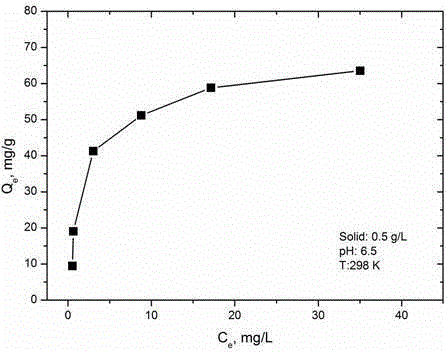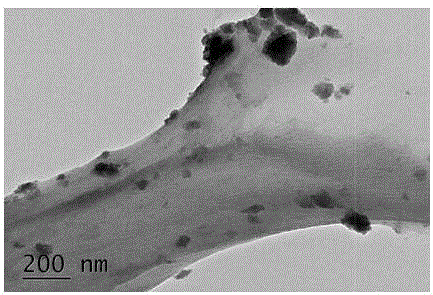Biomass-based nanometer lanthanum oxide dephosphorization composite adsorbent and preparation method thereof
A nano-lanthanum oxide and composite adsorption technology, which is applied in chemical instruments and methods, adsorption water/sewage treatment, and other chemical processes, can solve the problems of complex synthesis process, toxic by-products, environmental damage, etc., and achieve simple and clean synthesis process , high adsorption selectivity, and the effect of improving the adsorption capacity
- Summary
- Abstract
- Description
- Claims
- Application Information
AI Technical Summary
Problems solved by technology
Method used
Image
Examples
Embodiment 1
[0018] (1) Mix 6g of dried sawdust with 50mL N,N-dimethylformamide, ultrasonicate for 10min, stir at 25°C for 0.5h, then heat up to 60°C; then add 30mL of epichlorohydrin at 8mL / min Add dropwise to the mixture at a constant speed, stir and react at 60°C for 1 hour; then add 30mL of urea solution dropwise at a constant speed of 10mL / min, stir and react at 60°C for 2 hours. After the reaction, the product was washed with deionized water and ethanol and dried in vacuum at 40°C for 8 hours to obtain a biomass anion exchange resin containing a strong base quaternary ammonium group;
[0019] (2) Weigh 15gLa(NO 3 ) 3 ·6H 2 O was added to 150 mL of HCl solution with a concentration of 0.1 mol / L, the biomass anion exchange resin obtained in step 1 was added therein, and stirred at 25° C. for 3 hours. The material was filtered out with a strainer and dried, and then added to 100 mL of KOH (2.5 wt%) + KCl (2.5 wt%) alkali salt solution, stirred and reacted at 25°C for 4 hours. After ...
Embodiment 2
[0023] (1) Mix 10 g of dried corn stalks with 100 mL of N-N dimethylformamide, sonicate for 20 min, stir at 40 °C for 1 hour, and then heat up to 85 °C. Then, 60ml of epichlorohydrin was added dropwise at a speed of 15mL / min to the mixed solution at a constant speed, and stirred and reacted at 85°C for 2 hours. Then, 60 mL of trimethylamine solution was added dropwise at a constant speed of 15 mL / min, and stirred and reacted at 85° C. for 3 hours. After the reaction, the product was washed with deionized water and ethanol and dried in vacuum at 50°C for 12 hours to obtain a biomass anion exchange resin containing a strong base quaternary ammonium group;
[0024] (2) Weigh 25gLaCl 3 ·7H 2O was added to the 200 mL HCl solution with a concentration of 0.2 mol / L, the biomass anion exchange resin obtained in step 1 was added therein, and stirred at 30° C. for 5 hours. The material was filtered out with a strainer to dry, and then added to 200 mL of NaOH (5 wt%)+NaCl (5 wt%) alka...
Embodiment 3
[0028] (1) Take 15g of dried Arundos reed and mix it with 200mL N-N dimethylformamide, sonicate for 30min, stir at 20°C for 2 hours, then raise the temperature to 95°C. Then, 100ml of epichlorohydrin was added dropwise at a speed of 20mL / min into the mixture, and stirred at 95°C for 2 hours. Then, 90 mL of triethylamine solution was added dropwise at a constant speed of 20 mL / min, and stirred and reacted at 95° C. for 4 hours. After the reaction, the product was washed with deionized water and ethanol and dried in vacuum at 50°C for 16 hours to obtain a biomass anion exchange resin containing strong base quaternary ammonium groups;
[0029] (2) Weigh 35gLa(NO 3 ) 3 ·6H 2 O was added to the 300 mL HCl solution with a concentration of 0.3 mol / L, the biomass anion exchange resin obtained in step 1 was added therein, and stirred at 40° C. for 6 hours. The material was filtered out with a strainer to dry, and then added to 300 mL of KOH (5 wt%)+KCl (5 wt%) alkali salt solution,...
PUM
 Login to View More
Login to View More Abstract
Description
Claims
Application Information
 Login to View More
Login to View More - R&D
- Intellectual Property
- Life Sciences
- Materials
- Tech Scout
- Unparalleled Data Quality
- Higher Quality Content
- 60% Fewer Hallucinations
Browse by: Latest US Patents, China's latest patents, Technical Efficacy Thesaurus, Application Domain, Technology Topic, Popular Technical Reports.
© 2025 PatSnap. All rights reserved.Legal|Privacy policy|Modern Slavery Act Transparency Statement|Sitemap|About US| Contact US: help@patsnap.com


